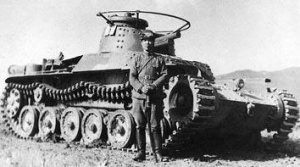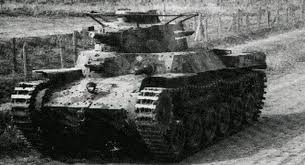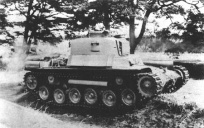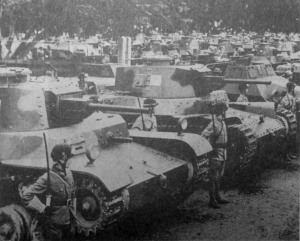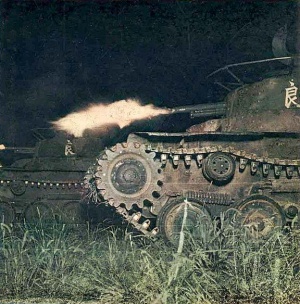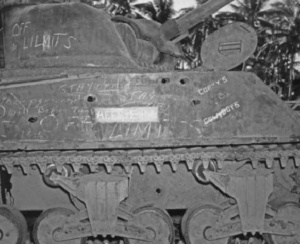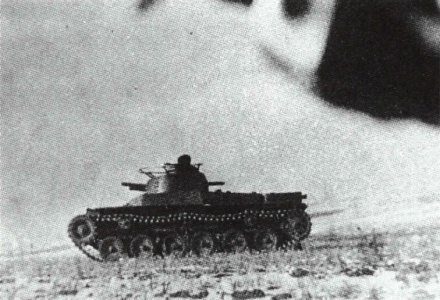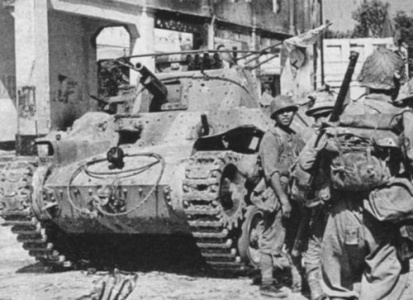Chi-Ha (Family)
Description
The Type 97 Chi-Ha (九七式中戦車 チハ, Kyūnana-shiki chū-sensha Chi-ha) was a medium tank used by the Imperial Japanese Army during the Second Sino-Japanese War, the Battles of Khalkhin Gol against the Soviet Union, and the Second World War. It was the most widely produced Japanese medium tank of World War II.
The 57 mm main gun, designed for infantry support, was a carry over from the Type 89 I-Go medium tank. The suspension was derived from the Type 95 Ha-Go light tank, but used six road wheels instead of four. The 170 hp Mitsubishi air cooled diesel engine was a capable tank engine in 1938.
The Type 97's low silhouette and semicircular radio antenna on the turret distinguished the tank from its contemporaries. After 1941, the tank was less effective than most Allied tank designs. In 1942, a new version of the Chi-Ha was produced with a larger three-man turret, and a high-velocity Type 1 47 mm tank gun. It was designated the Type 97-Kai or Type 97 Shinhoto Chi-Ha.Vehicles
Rank I Vehicle
Rank II Vehicle
History
Design
The Type 97 Chi-Ha was a medium tank constructed with rivets in the armour plates. It had a crew of four with a two-men turret. The turret held the same low-velocity 57 mm gun from the Type 89. Armour was relatively thin, but quite standard at the time of 1930s, but this would become very vulnerable past 1941 when the Japanese war expands to the world.[1]
Development
Type 97 Chi-Ha
With the Type 89 I-Go fast becoming obsolete in the late 1930s, the Imperial Japanese Army (IJA) began a program to develop a replacement tank for infantry support. Experience during the invasion of Manchuria determined that the Type 89 was too slow to keep up with motorized infantry. The new medium tank was intended to be a scaled-up four-man version of the Type 95 Ha-Go light tank, although with a two-man turret, thicker armor, and more power to maintain performance. The Tokyo factory of Mitsubishi Heavy Industries completed a prototype designated Chi-Ha. The second prototype was completed in June 1937. Although the requirement was for a 47 mm gun, it retained the same short-barreled 57 mm gun as the Type 89B tank. However, at the time IJA was also interested in the lighter and less expensive Type 97 Chi-Ni prototype proposed by Osaka Army Arsenal, which had the same 57 mm main gun. With the out-break of the Second Sino-Japanese War on 7 July 1937, the peacetime budgetary limitations were removed and the more capable and expensive Mitsubishi Chi-Ha model was accepted as the new Type 97 medium tank by the army.Type 97 Chi-Ha Kai
The shortcomings of the Type 97, with its low-velocity Type 97 57 mm gun, became clear during the 1939 Battles of Khalkhin Gol against the Soviet Union. The 45 mm gun of the Soviet BT-5 and BT-7 tanks out-ranged the Japanese tank gun, resulting in heavy Japanese losses. This convinced the army of the need for a more powerful gun. Development of a new 47 mm weapon began in 1939 and was completed by 1941. The Type 1 47 mm tank gun was designed specifically to counter the Soviet tanks. The 47 mm gun's longer barrel generated much higher muzzle velocity, resulting in armor penetration superior to that of the 57 mm gun. The new version, designated Type 97-Kai ("improved") or Shinhoto Chi-Ha ("new turret" Chi-Ha), used the 47 mm main gun in its new, larger three-man turret. It replaced the original model in production in 1942. In addition "about 300" of the Type 97 tanks with the older model turret and 57 mm main gun were converted.Further Development
The Type 97 Chi-Ha, like the standard tanks of other countries, was used in a multitude of roles by adapting its chassis to another purpose such as the Ho-Ni assault gun series. The Type 97 Chi-Ha design was also improved upon multiple times with better armour and better guns, the last design that was based directly on Type 97 lineage was the Type 3 Chi-Nu medium tank with a 75 mm main gun of which 144 were built from 1944 to 1945. The Type 3 Chi-Nu retained the same chassis and suspension of the Type 97 based Type 1 Chi-He tank, but with a large new hexagonal gun turret and a commander's cupola. The Type 4 Chi-To was a separate design, the last Japanese medium tank design to be completed during the war, considered equivalent to the German Panther tank, but with only two known to be completed by war's end. By the time, the Japanese industry had been badly crippled by the American bombing campaign; as a result, few of these newer vehicles were ever built.
The IJA's need to supplement their tank units with artillery led to a need for self-propelled guns (SPGs). Subsequently, the Type 97 chassis was utilized to manufacture nearly a hundred SPGs, consisting primarily of 75 mm guns. Since the IJA's 1930's era tanks didn't have the firepower to penetrate the 1940s generation of Allied armor, a need for tank destroyers arose, and experiments ranging from 47 mm to 120 mm guns were conducted. However, due to naval priorities, raw materials for any IJA production were limited.Combat History
The Type 97 was deployed in China in combat operations in the Second Sino-Japanese War with considerable success, as the ill-equipped National Revolutionary Army of the Republic of China forces were limited to only three tank battalions consisting of British exports of the Vickers, German Panzer Is, and Italian CV33 tankettes.
Its first real test in combat against opposing armor came with the Battles of Khalkhin Gol in July 1939 against the Soviet Union. The IJA 1st Tank Corps consisting of the 3rd and 4th Tank Regiments (Yasuoka Detachment) had been assigned to the Nomonhan region, under the command of Lt. General Yasuoka Masaomi. Of the two regiments, only the 3rd Tank Regiment had been supplemented with four of the new Type 97 medium tanks. One was selected as the regimental commander's tank.
During fierce fighting against the Red Army, the 3rd Tank Regiment was assaulting an objective ringed with strung coiled wire (piano wire). The regimental commander, Lt Col. Yoshimaru Kiyotake's Type 97 tank became entangled up to its drive sprockets. Struggling to extract itself from the tank trap, Yoshimaru managed to move his tank rearward about 40 metres, when his machine stopped completely. Exposed to Soviet defensive positions, Yoshimaru's Type 97 was subjected to the fire of a dozen Soviet BT-7 tanks and anti-tank guns. Soviet shells struck the tank's drive gear, hull, and the engine area, causing the vehicle to erupt into flames. When the fire reached the tank ammunition, the tank exploded, tearing off the turret and throwing it several feet away from the hull. Only the tank's gunner, who abandoned it, prior to the explosion, was uninjured. Yoshimaru's commander's body was recovered after the battle.World War II
From 8 December 1941 and into early 1942, during the Battle of Malaya and the Battle of Singapore, Type 97 tanks were used by the 3rd Tank Group's 1st, 6th, and 14th Tank Regiments under the command of Lieutenant-General Yamashita. The 1st Tank Regiment was attached to the IJA 5th Division, which was among the first Japanese military units to land at Songkhla in southern Thailand. One of its medium-tank companies was the 3rd Tank Company under First Lieutenant Yamane's command (comprising ten Type 97 medium tanks and two Type 95 Ha-Go light tanks), forming part of the "Saeki Detachment". The company was in the vanguard of the attack on northern British Malaya at the end of 1941. Later on, this same unit would be involved in forcing the defending British forces to abandon much of northern Malaya in the decisive Battle of Jitra at the start of 1942.
One key to the overall Japanese military successes in Malaya and Singapore was the unexpected appearance of their tanks in areas where the British did not believe tanks could be fielded. The thick and wet jungle terrain did not turn out to be a decisive obstacle for the generally light Japanese tanks. Later on, the 2nd and 14th Tank Regiments participated in the Burma Campaign from 1942.
The Type 97 ShinHoTo Chi-Ha tanks were first used in combat in the battle of Corregidor in 1942. The updated 47 mm gun was easily capable of dealing with the armor of the American M3 Stuart light tanks, although in later combat service it was shown only to be effective against the sides and rear of the M4 Sherman medium tank.During the Battle of Saipan on the night of 16–17 June, Type 97s of the 9th Tank Regiment, joined with Type 95s of the 136th Infantry Regiment in an all-out counterattack against the established beachhead by American Marines that had landed the day before. Led by the 44 tanks from the 9th, the Type 97s and Type 95s were knocked out by a Marine platoon of M4A2 tanks, several M3 75mm half-tracks, bazookas and 37mm antitank guns. It was the largest Japanese armor attack of the Pacific Theater of Operations. However, the Japanese Army seldom made major armored attacks during the Pacific War due to the limited maneuvering areas that prevailed on islands in the South Pacific ocean. Terrain dictated the battle and IJA tanks were emplaced in hull defilade positions or even buried up to their turrets.
During the Battle of Guam, 29 Type 97 and Type 95 tanks of the IJA 9th Tank Regiment and nine Type 95s of the 24th Tank Company were lost to bazooka fire or M4 tanks.
At the Battle of Okinawa, 13 Type 95's and 14 Type 97 Chi-Ha Kai tanks of the understrength IJA 27th Tank Regiment faced 800 American tanks of eight US Army and two USMC tank battalions. The Japanese tanks were defeated in their counter-attacks of 4–5 May 1945.
Similar conditions were repeated in the Kwantung Army's defense against the Soviet invasion of Manchuria, although there was little tank-versus-tank action. The Soviet Red Army captured 389 tanks.After World War II
Some Japanese tanks remained in use, under new ownership, postwar during the Chinese Civil War. After the end of World War II, Type 97 tanks captured by the Soviets were turned over to the Chinese Communist army. After victory, the Chinese People's Liberation Army (PLA) continued to use them in their inventory. The PLA's force of 349 tanks in 1949 consisted mainly of Japanese Type 95 Ha-Go and Type 97 tanks.Variants (In-Game)
Medium Tanks
- Type 97 Chi-Ha
- Type 97 Chi-Ha Kai
- Type 1 Chi-He (Successor)
Gun Tank
SPG's
Media
- Chi-Ha Kai Destroyed.jpg
Battle for Iwo Jima, February-March 1945.
- ↑ Zaloga Steven. Japanese Tanks 1939-1945 Great Britain: Osprey Publishing Ltd., 2007


